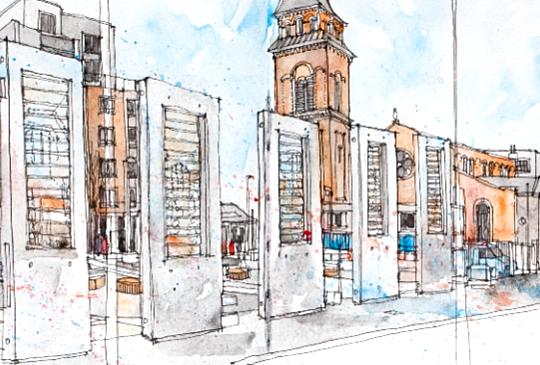
Haven in the city: parks and squares
~
Nothing becomes a city so much as its parks and squares. We can enjoy them and, in whatever ways we can, cherish them. You may choose to eat your lunchtime sandwich, doze or tweet from these places. You may picnic with friends or sit with a book. Or you might just take out a sketchbook and look around you intently.
Whatever it is that draws you into these places, you will experience life in the city centre in a different way. We are not always working and shopping, sometimes we might move through the city for the sheer pleasure of it. These are some of the places you might find, stop in, and take great pleasure from. You are most welcome.
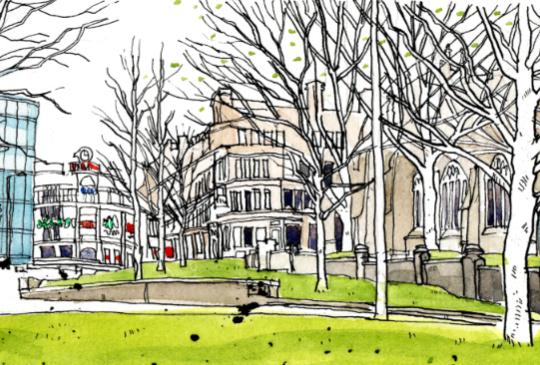
Cathedral Gardens
Cathedral Gardens (M4 3BG) was created in 2002 as part of Manchester’s Millennium Quarter. By folding Urbis (now housing the National Football Museum) around the Corporation Street edge of the site, architect Ian Simpson created a unique glass backdrop to a brand new green space in the city. The gardens themselves were designed by Building Design Partnership, following the 1996 IRA Bomb. Ironically, it was enemy bombs that first created the entire site in the 1940 Christmas Blitz.
Manchester Cathedral, Corn exchange, Chetham’s Library and School of Music and Victoria Station bound the Gardens. With Manchester Arena just around the corner, and future development of the Medieval Quarter and NOMA, this is not about to be an especially quiet space anytime soon. It will only become more vibrant. From its opening to the present, Cathedral Gardens has been adopted by Moshers, Goths and emos from all over the city, dress code, Marilyn Manson, Slipknot, a lot of black. People watching, street theatre. A unique space in the city.
Cutting Room Square
If you want an example of visionary regeneration, this is it. Cutting Room Square, Ancoats, is watched over by five giant monoliths. each frames an enlarged photograph by Ancoats artist-in-residence, Dan Dubowitz, of the derelict, over-grown spaces where women used to cut the paper patterns for the thousands of fabrics and garments that were made here and exported to the world. Royal Mill, where these photographs were taken, is now converted into apartments and people cook, take showers and watch TV where thousands of mill workers turned in for their shift.
Cutting Room Square (M4 5AH) opens on to St Peter’s church. Completed in 1859 this pretty Italianate building was the first Anglican Church in this predominantly Catholic area. A century and a half later it was abandoned, looted and burnt out. Beautifully restored, it is now the rehearsal and small performance space for the hallé symphony orchestra, itself founded in the city just two years prior to the church being built. Look around you. Nowhere in Manchester will give you a stronger sense of the city’s industrial past, and nowhere bears the city’s cultural identity so positively represented.
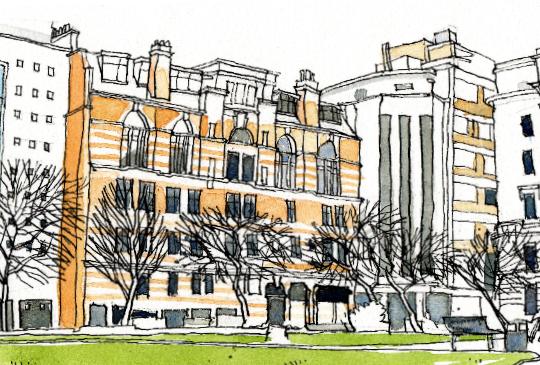
Parsonage Gardens
If it wasn’t called Parsonage, it could fittingly be called harry’s Gardens. The Parsonage was of St Mary’s Church, built in 1753, closed in 1890 when the congregation had abandoned
the polluted industrial city centre. The Church was demolished in 1928, as the great white five-storey cruise ship of Arkwright house, by architect harry S Fairhurst, took up the entire south side. Harry also designed National house, its neighbour to the west, headquarters building for the National Union of Boilermakers.
It was (rather well) converted into flats, along with its 1960s neighbour, also by Fairhurst’s, in 2000. The great harry Fairhurst, Manchester’s most significant architect after Alfred Waterhouse, also designed Blackfriars house, another bright white Portland stone liner of a building, just a step down the street.
Parsonage Gardens (M3 2LF) is no great work of landscape design; cruciform paths run corner to corner and dissect a small central circle. The plantings aren’t great. Grab a sandwich and an early lunch and head across Deansgate, past Kendal’s, down St Mary’s Street on the next fine day, and discover that even the plainest, least adorned space can be a haven in the city.
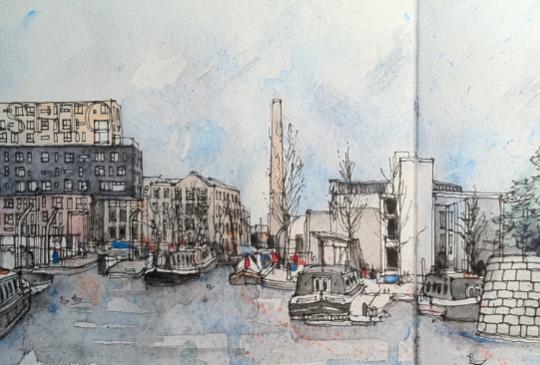
Cotton Field
The Ancoats cotton mills made Manchester a global brand. The sheer cliff face of mills on Redhill Street, looking south across the Rochdale canal is one backdrop to the city’s newest park. Another is the colourful Chips apartment building by architect Will Alsop, sitting on the bank of the Ashton canal. The area is New Islington, and the brand new water and wildlife park, named by popular vote, is Cotton Field (M4 6EE).
Orchard, beach, reed-beds, nesting boxes, turning bridges and mooring pontoons. Building in New Islington might have been cruelly stalled by the recession, but life, and nature drives on. even the outdoors furniture here, whether concrete or timber, has flare and quality. All the moorings are taken and there’s a fragrant year- round community of wood-burning stoves aboard colourful narrow boats. There is no other city centre community, neighbourhood or park quite like it.

Piccadilly Basin
Today we’d call it a Transport hub. Piccadilly Basin (M1 2HG) was once a buzzing interchange of horse drawn barges and drays, cotton bales, coal and all the timber, brick and iron an industrial cauldron could consume. The Rochdale Canal Company offices were on Dale Street, in front of Carver’s warehouse, built in 1806, the oldest in the city. The basin was a maze of wharves, docks, pools and moorings, where the Rochdale and Ashton canals meet.
Filled in for a car park, the area was a neglected backwater, without much water. There’s still car parking here, but also plantings, footbridges, towpaths and a properly reconstituted waterside. New and refurbished offices, apartments and hotels make this a modern hub of a very different order. Piccadilly Basin is an exciting and historic contribution to Manchester’s open spaces. It anchors the southern margin of the Northern Quarter and links through to Ancoats. Piccadilly Basin is the counter balance to Castlefield. Get there along the Rochdale canal, past the only canal lock in the country that sits beneath a building!
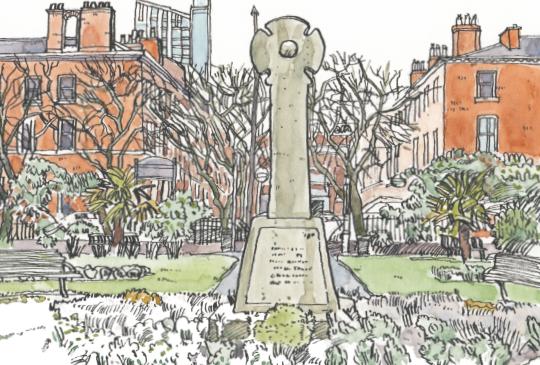
St John's Gardens
St John’s Gardens (M15 6BH), the park, and the neighbouring 1970s housing development that shares the name, are very like a small corner of a different city. St John Street, leading down from Deansgate to the park, is Manchester’s last intact Georgian street. Legal, medical and dental moved in years ago and there are no private houses here now. however, west of the park, between Byrom Street and Lower Byrom Street, is a congregation of more than a hundred town houses and maisonettes, enclosing four internal gardens.
St John’s church was demolished in the early 1930s. The graveyard that the gardens have replaced had tombstones laid flat, edge- to-edge, like flag stones. The memorial cross tells us that 22,000 people are buried here, which is a number best not to contemplate when enjoying sunlit lunches. John Owens is buried here, founder of the college that became Manchester University. Also, and perhaps more restfully, is William Marsden, campaigner for the Saturday half-day holiday. Rest in peace.
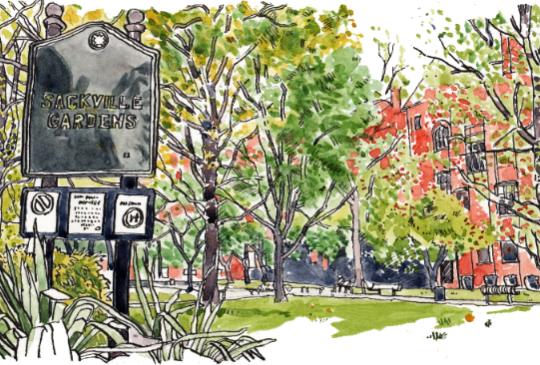
Sackville Gardens
This was Whitworth Gardens until a revamp brought in the Beacon of hope in 2000 and the bronze memorial statue of Alan Turing by Glyn hughes a year later. It is now Sackville Gardens, and very much the adopted heart of the Gay Village, being the staging area for the annual candle light vigil on 1 December, World Aids Day. This is a space where thinking is allowed.
Held in by the Rochdale canal, former Sheena Simon College, Whitworth Street and the magnificent main building of the University of Manchester Institute of Science and Technology, Sackville Gardens (M1 3HB) looks out onto a uniquely modern recasting of the city. Through the last decade of the twentieth century the long established gay community came out in the pubs, clubs and bars of Canal Street and helped change the world that had so cruelly victimised mathematician, scientist and gay icon Alan Turing, for good. The 1870s warehouses at 42 – 44 Sackville Street were the first in the city to get the full ‘loft living’ conversion.
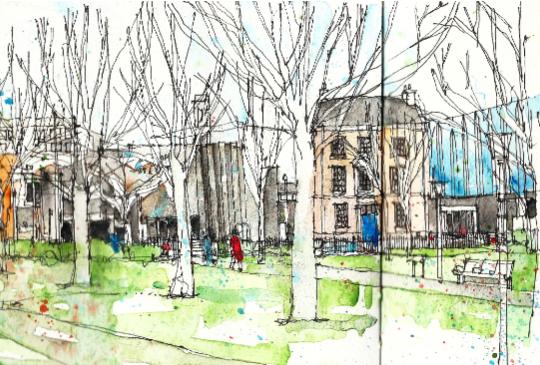
All Saints Gardens
“All Saints no sinners!” was invariably the bus conductor’s cry when they reached this stop on Oxford Road. This is Grosvenor Square, Chorlton-on-Medlock, and it’s been pretty posh in its time. In fact, the grand Town hall, with its Greek inspired classical portico, by Manchester architect Richard Lane, is quite a statement. This characterful and lively square is surrounded on three sides by Manchester Metropolitan University, whose students form a pretty dense carpet on sunny days before exams. Lunchtime tastes are catered for by various takeaways that cover the gastronomic spectrum from A to B. Vitamin C is abundantly provided by Nick Austin’s perpetual fruit and veg van.
The great thing about squares and parks such as this is that surrounding buildings are all front. The mix of buildings here is superb. From Georgian to Victorian, edwardian, Thirties and up to the present, in the flashy new Business School in the far corner. A personal favourite is the wonderful 1960s blue brick St Augustine’s church by another great Manchester architect, Desmond Williams. Go inside. The top-lit sanctuary and massive ceramic altarpiece by Robert Brumby are amongst the very finest of the period anywhere in the country. Sanctuary inside and out. This is All Saints Park. hardly a sinner in sight.
About
Haven in the City was produced by Marketing Manchester in partnership with Creative Concern; the original idea emerged in conversation with Nick Johnson. The words are by Phil Griffin, a writer, broadcaster and curator with special interest in architecture and urban issues. He is busy preparing his next 'Pop-up Gallery' at the moment. The images are all courtesy of Manchester's Urban Sketchers group, specifically Caroline Johnson who studied art in Preston, Falmouth and London and is Manchester’s officially appointed Urban Sketcher; and Simone Ridyard who teaches Interior Design at Manchester Metropolitan University. She set up the MMU Urban Sketchers Group.
Contributor Profile
Freelance writer, broadcaster and curator with special interest in architecture and urban issues. If you haven't caught if already, his TEDxManchester talk on the city's architecture is a rare treat. He's also responsible for an ongoing, and successful series of pop-up galleries.

